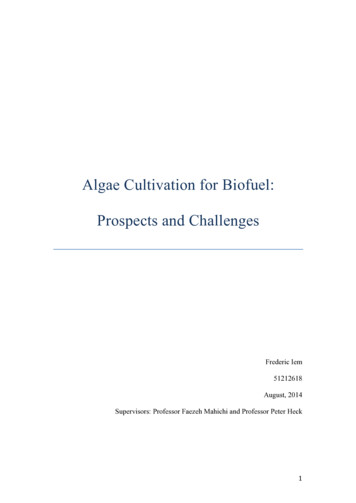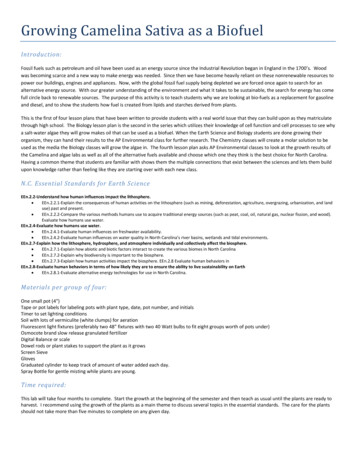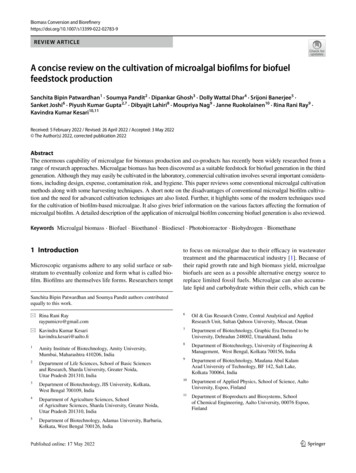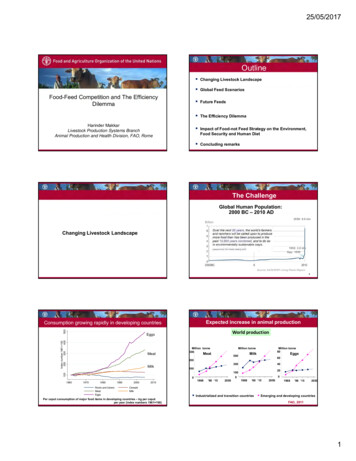
Transcription
Algae Cultivation for Biofuel:Prospects and ChallengesFrederic Iem51212618August, 2014Supervisors: Professor Faezeh Mahichi and Professor Peter Heck1
Table of ContentsTable of arch Objective.8Hypothesis and further discussion.9Expected Outcomes and Landscape.92.1 Introduction to Biofuel.92.1.1 Biodiesel.112.1.2 Bioalcohols.122.1.3 Bioethers.132.1.4 Biogas.142.1.5 Biooil.142.1.6 Synthesis Gas.152.2 Biofuel Classification.152.2.1 First Generation.152.2.2 Second Generation.162.3 Biofuel Production.162.3.1 Biomass Feedstock.172.4 Role and Benefits of Algae in Biofuel Production.182.4.1 Usage of biodiesel.192.4.2 B100.202.5 Types of Algae.212
2.6 Microalgae Derived Biofuel.222.6.1 Microalgae Combustion.222.6.2 Methane Production.222.6.3 Ethanol Production.232.6.4 Hydrogen Production.232.6.5 Oil Production.242.8 Microalgae Culture and Limitation.252.9 Algae cultivation and Integration in modern farming.262.9.1 Algal biofuel and Aqua Culture.28Cost Analysis.303.1.1 FARM Model.313.1.2 Scenarios.323.1.3 Electrocoagulation.343.1.4 HTL-CHG.343.1.5 ARID.353.1.6 Scenario 1.363.1.7 Scenario 2.363.1.8 Scenario 3.373.1.9 Scenario 4.373.2.0 Scenario 1 Results.383.2.1 Scenario 2 Results.413.2.2 Scenario 3 Results.443.2.3 Scenario 4 .513
Conclusion.51References.534
AbstractIn today’s world energy has become an important issue, not only foreconomically advanced countries, but for those developing as well. The increase inenergy prices and fossil fuel shortages has led many to seek a new solution towardsthis energy crisis. Alternative energy is the key answer to this problem, but what kindof alternative energy is most beneficial remains an unknown. There are many formsof alternatives energy from those renewable energy such as wind and solar to energywhich are created through the harvest and processing of natural raw materials. Algaeare one of those ingredients that are now being looked upon as a possible answer tothe creation of biofuels. This research report will analyze the different types of algaebased biofuels as well as examine the many methods that turns algae to biofuelthrough findings based upon economical viability. Although algae are a great sourceof biofuel, where its use allow for food crop nurture grounds to be free for use, thetechnology itself still remains expensive, however reliable. For full benefits of algaebased biofuel more research must be exerted and different methods should be usedbased upon the type of algae and the geographical location of the biofuel plants.5
IntroductionAlgae is comparable to that of a sleeping giant, virtually unlimited potentialwhen it comes to energy, but all of its potential has not yet been brought out and fullyutilized. In today’s modern world, algae is cultivated and used mostly to produce andcreate human nutritional products, only a small amount is placed into the biofuelindustry. Research regarding algae and biofuel is still an ongoing business that has yetto be resolved. Many question arises when it comes to algae’s potential as a feedstockfor biofuel; Is it worth while cultivating? High yields or low yields? Is it economicaland sustainable?Today there are many ways to farm and many ways to harvest crops, with newand more sophisticated technologies being created virtually everyday. However mostof the crops grown are still the ones that have been grown for centuries, and thus thebenefits are relatively unchanged, although the amount of crops to be produce mighthave increased with the improved level of technology. Algae could be considered anew type of crop, with multiple new benefits as well as advantages in its cultivationprocess. Therefore it serves not only as a new energy alternative, but also a reliableeconomical crop for the agriculture sector as well.Although more and more technology has been developed to support algaecultivation, to say that algae can be easily cultivated for biofuel synthesis purposes isstill not yet a reality. There are some difficulties in the sustaining an abundanceamount of algae culture through simpler and less technology oriented methods, suchas the open pond method. Mass cultivation of algae on the other hand is prosperingand giving extremely positive results. Despite some issues regarding production algae6
is nonetheless a very viable source of energy with various economical andenvironmental benefits. When it comes to algae anyone can cultivate them, but noteveryone will be successful. However those that are, algae is without a doubt one ofthe best, and most sustainable, feedstock for biofuel that is available, with high valueenergy conversion and with waste water treatment benefits.BackgroundEnergy consumption has steadily increased since the 1970’s. It is reported thatglobal energy use, has risen approximately 70% since the 1970’s and will continue torise dramatically in the future, due to increased economic development throughout theworld (International Energy Agency). Energy demand is projected to continue risingat a rate of over 2 percent each year, according to the International Energy Agency orIEA. Enerdata Publications also stated that there was over a 5% increase of worldenergy use in 2010.Renewable resources serve as an alternative to potentially more dangerousenergy, such as nuclear power plants. Renewable Energy Policy Network for the 21stCentury, REN 21, states that renewable energy is energy that comes from nature.Therefore extracting energy from algae and using that energy in the form of biofuel, isa potential renewable energy source that could prove to be beneficial not only to theeconomy, but the environment as well.Stefani Newman, a writer for Discovery, elaborates that President JimmyCarter first mentioned the topic of algae as a potential source for energy in 1978. Thetopic was brought up due to a dire issue related to oil or gas prices which werecontinuously increasing, and the government was trying to look for potential methodsto alleviate the situation. After extensive testing it is found that high-yielding plants,7
algae included, could become a viable alternative. “After testing more than 3,000types of algae, the program concluded that the high-yielding plant, if produced inlarge enough amounts, could replace fossil fuels for home heating and transportationpurposes.” (Newman, S.)Research ObjectiveThere are a number of crops that are used in the production of biofuel, namelycorn and switchgrass. Algae has some unique qualities that other biofuels aresignificantly lacking. Algae does not use precious farmland, which is much neededfor consumable crops. It also does not need harmful commercial fertilizers in order tosustain an adequate production.According to the United Nations World Food Program (WFP), as the price offood increases, it becomes more and more difficult to provide food for the poor andmalnourished. If algae were to be used as a source for biofuel instead of other biofuelcrops, like corn and switchgrass, there would be more farmland available to grow theagricultural crops, so needed throughout the world. This increased production ofconsumable agricultural crops, could possibly make great strides in alleviating worldhunger.This research will help explain how algae cultivation could be botheconomical and environmental, and that it is a viable new agricultural crop not onlyfor developed countries, but developing countries alike. If it can be shown, that algaeis a prominent and sustainable product for biofuel synthesis, then this research couldhelp promote awareness in this field and further develop the biofuel industry.Furthermore this research is to explain on the possible benefits of convertingconventional farming to algae farming.8
Hypothesis and further discussionAs algae and many land crops share common components, such as thestructure, which is composed cellulose, its use as a source of biodiesel would mostlikely be possible. Algae does not take up as much land as other plants, could becultivated in arid land, and so maybe a more economically stable crop or potentialsource for biodiesel.Expected Outcomes and LandscapeIf the outcome of this research would match that of the expected result andhypothesis, formerly mentioned in corresponding sections, then algae would be aviable candidate for biodiesel; with proper usage and implementation of thetechnology it could be use to add to the declining fossil fuel reserve we currently haveand somewhat alleviate problem that relates to fuel shortages and rising gas prices.2.1 Introduction to BiofuelConventional fuels that are the products of nature; including gas andpetroleum, which are the products of hydrocarbon, are the being used rapidly today.Naturally these conventional fuels do replenish themselves but very slowly, muchslower than the rate at which they are being used now.9
Biofuels are nonconventional fuels, also referred to as alternative fuels.Biofuels are usually manmade products, which is synthesized and used as 011)explains,“nonconventional fuels (alternative fuels) are any materials or substances that can beused as fuels, other than conventional fuels” (p. 3). The name biofuel refers to aplatitude of different alternative fuels, including biodiesel, biomass, and bioalcohol,which include methanol, ethanol, and ethanol. Biofuel is derived from virtually anyorganic substance or any kind of biomass. “A biofuel is any fuel that is derived frombiomass, i.e. recently living organisms or their metabolic byproducts. Biofuel has alsobeen defined as any fuel with an 80% minimum content (% v/v) of materials derivedfrom living organisms harvested within the ten years preceding its manufacture”(Speight, J.G. 2011, p.169). The ideal source would be one that can be replenished ata fast pace. Plants are the top candidates as they are a good source of carbon, and theirgrowth can be easily maintained and influenced with modern day technology.Although there are different forms in which biofuels come, the most widelyused one would be liquid. Ethanol-derived fuels are among the most used commercialliquid biofuel. According to Hansen, Kyritsis, and Lee (2010) most ethanol areproduced from “grain, sugarcane, or sugar beet, and biodiesel produced from a varietyof vegetable oils and animal fats” (p. 3).Although there are many different feedstock for biofuel, this report will focuson algae, and its different forms, as a feedstock alternative for biofuel. As algae is acrop that might hold significant benefits with advantages over conventional land crops.Algae are not grown on land and thus might be an answer for countries where arableland is scarce or for those that have food shortages and need all the available arableland to plant food crops. Algae can also be cultivated quickly some species can grow10
at a very rapid rate. With today’s ever advancing technology algae is becoming amore viable source for the synthesis of biofuel. Further elaboration on algae’scompetitive edge will be referred to in chapter 2.9. This chapter will continue toexplain and explore in detail the types of biofuels that are available today.2.1.1 BiodieselBiodiesel is a product usually made of vegetable oil or animal fat. Combiningthe biomass, in this case the oil, with a base, which is sodium hydroxide, andmethanol, produces Biodiesel (Figure 2.1). Biodiesel’s structure is very similar to thatof conventional diesel, with many shared traits and properties it can be easily mixedwith diesel and used, thus allowing a reduction in price, since biodiesel processing isgenerally cheaper than that of diesel.11
Figure 2.1 Biodiesel Production Process(Utah Biodiesel Supply, 2005)2.1.2 BioalcoholsBioalcohols are the result of a fermentation process. Speight (2011) explainsthat bioalcohols are “produced from the fermentation of sugars by various enzymesand micro-organisms” (p. 173). Conventional feedstock for bioalcohols are sugar cane,wheat, corn, or any saccharide source that alcohol could be obtained from, this also12
include some form of algae such as kelp. The bioalcohols that this report will focus onare the two more well known bioalcohols; biobutanol (Figure 2.1) and bioethanols.Ethanol is the most popular among bioalcohol due to some of its distinctive qualities.“Ethanol is the most widely produced, since it is biodegradable and reduces harmfulnoxious emissions” (Speight, J.G. 2011, p. 173). Ethanol also burns with a highoctane value, and can be synthesized from highly renewable source, i.e. microalgae,making it a cheap alternative compared to petrol. Biobutanol that is the result form thefermentation of acetone has been claimed to be a candidate for the replacement ofconventional gasoline. Speight (2011) mentions that biobutanol can help improvevehicle fuel efficiency as well as offer better fuel economy.2.1.3 BioethersBioethers are made from bioalcohols and was first introduced in the 1970’s asan alternative to lead, which is usually a component in conventional fuel. It is claimedtha bioethers or fuel ethers can helpl enhance engine performance as well as reducethe toxic exhaust emissions. According to EFOA (European Fuel OxygenatesAssociation) the best route for biofuels is bioether as bioether helps improve airquality, reduce carbon dioxide emission, and overall contribute to a betterenvironment. Bioethers characteristics are overall similar to that of the previouslymentioned bioalcohols.13
2.1.4 BiogasBiogas, as the name implies is gas made from the fermentation of organicmatter through anaerobic digestion. Biogas also have different names depending onwhere it is produced, it maybe known as swamp gas, marsh gas, landfill gas, anddigester gas. Algae can also be used to create biogas, referred to as algal biomass,where algae are fermented so that anaerobic reaction occurs and biogas is produced.Biogas is similar to natural gas, and thus can be used in the same mannergranted that the quality of the biogas is high, as most biogas must be cleanedthoroughly before use.2.1.5 BiooilBiooil is somewhat equivalent to crude oil and is also called biocrude. Biooilis the product of biomass that has undergone pyrolysis and thermochemicalconversion. Pyrolysis refers to the process in which an organic material is exposed toextremely elevated temperatures so that change in chemical composition occurs.Biomass is that is general used for the synthesis of biooil include crop residues, wastepaper, and other organic wastes. Although algae can be used for the production ofbiooil there are other materials that may prove to be cheaper and are less timeconsuming to gain access to. Therefore algae for biooil are not a suitable derivationand should be exempted. Biooil can be processed and converted into fuel, such asbiodiesel.14
2.1.6 Synthesis GasSythesis Gas or syngas (Syngas Biofuels Energy, Inc., 2009) is the result froma process known as gasification. The materials used are organic matters, usually wood,organic waste, biomass, and even fossil fuels such as petroleum can be used.Gasification is the conversion of the aforementioned materials into carbon monoxide,hydrogen, and carbon dioxide by reacting the materials at an elevated temperature( 700 degrees celcius) without combustion.Syngas is used to produce hydrocarbons or methanol. Furthermore syngas canbe used directly in engines instead of fossil fuels.2.2 Biofuel ClassificationBiofuel is usually classified according to its method of preparation, which isrelated to the material composition of the biofuel. Furthermore the classification isdistinguished by the starting material in the composition structure of the biofuel, ingeneral there are two classification; first generation and second generation.2.2.1 First GenerationThe first generation of biofuel refers to those that are synthesized or createddirectly from biomass. This can be explained further that the biomass used is usuallydirectly a part of a food chain, for example first generation biofuels can be made from15
different types of starch and sugars. First generation biofuels after purification andcleaning can be used for various equipment as well as vehicles.2.2.2 Second GenerationContrary to first generation biofuel, second generation biofuels are usuallycreated from materials, or rather biomass, that is not ordinarily part of the food chain.Therefore examples materials that go into the production of second generation biofuelwould include urban wastes, and waste from agriculture, or lists of biomass from thelandfills. The benefits from second generation biofuel is that, it does not threaten foodsupplies, as well as biodiversity of the community in which it is being produced. Themain material component in second generation biofuel is cellulose and thus they arealso known as cellulosic fuel. Cellulose for the second generation could come inabundance from residual forest biomass.Studies in second generation biofuel is increasing as when compared to firstgeneration biofuel it is considered to be more environmentally friendly as well asbeing more sustainable. First generation biofuel can sometimes produce a largeamount of carbon dioxide and thus does not contribute to a state of betterenvironmental protection compared to that of the second generation.2.3 Biofuel ProductionThere are multitudes of different unique method one can use for the synthesisof biofuel. From simple biofuel creation by mixing lipids and alcohol to the more16
sophisticated production using biorefinieries. As this report will deal with theimportance of algae in the fields of biofuel; this report will only cover methods thatare applicable to microalgae, which comes to a total of five different possible methods– further elaborated in chapter 2.6.2.3.1 Biomass FeedstockApart from the different types of algae that is available as feedstock for thesynthesis of biofuel there are many other options that are available for biomass aswell. Biomass energy sources are wood and wood wastes, municipal solid waste,agricultural waste, food waste, animal waste, and aquatics plants and algae.When it comes to feedstock for biofuel, its sufficiency as biomass energydepends on various sectors. Speight lists different issues: chemical composition o thebiomass, cultivation practices, availability of land and land-use practices, use ofresources, energy balance, emission of greenhouse gases, acidifying gases and ozonedepletion gases, absorption of minerals to water and soil, injection of pesticides, soilerosion, contribution to biodiversity and landscape value losses, farm-gate price of thebiomass, logistics cost (transportation and storage of the biomass), direct economicvalue of the feedstock taking into account the coproducts, creation or maintenance ofemployment, and water requirements and water availability.17
2.4 Role and Benefits of Algae in Biofuel ProductionSeaweeds and microalgae are important not only in the biofuel industry and itshistory extends long into the history of cultivation. They are a commercial productand thus are subject of interest to many different group of individuals, whetherscientist or merchants. The topic of algae as a source of energy came into views in the1970s. As the price of energy rises, alternative fuels become more and more important,and even within those list of possible materials, there are those that are moresustainable, some that are economically beneficially, but perhaps algae holds theanswer to both side of the spectrum as it can be both extremely economical and at thesame time sustainable.Algae have many benefits over other land-based fuel crops, or feedstock alsoreferred to as high plants, when it comes to biofuel production. The first and foremostis their ability to grow in water; this allows the avoidance of water related problemsand nutrients limitation. Another most coveted advantage is that algae can becultivated at a rate that is considered close to maximal productivity. Algae does nothave unproductive parts, whether it be roots or stems, thus allowing for more growthin limited space, as well as maximum conversion rate from their raw form to energy.The second and one of the biggest advantages of algae is that, they can begrown virtually anywhere. Algae do not require arable land and can be grownhorizontally in ponds with virtually any kind of water; brackish water, saltwater, orfreshwater. Algae can also be grown vertically, as recently companies develop what iscalled a bioreactor system (Figure 2.2), and algae are suspended in a clear containerand exposed to sunlight on both sides, while water and carbon dioxide is pumpedthrough the system. This ease in cultivation would allow for algae to be grown in18
countries or areas with limited arable land as well as for those with problemsregarding food shortages. As algae require less space, the arable land that is availablecould then be used for food crop cultivation.Figure 2.2 Bioreactor System(howstuffworks.com, 2008)2.4.1 Usage of biodieselBiodiesel use is increasing gradually every year, with Europe and theAmericas being pioneers in this field. Indifferent from the conventional diesel fuel,biodiesel can be used in virtually all standard diesel engines, for vehicles andmachines. Although biodiesel can be used independently on its own in theaforementioned biodiesel engines, it is usually blended before use. Blended biodiesel19
refers to the process in which biodiesel and regular, conventional, diesel is blendedtogether to create a new blend of fuel.Biodiesel blends have different names depending on the percentage ofbiodiesel that is in the formula. Different blends are distinguished by name withemphasis on the B factor. For example a blend with 20 percent biodiesel would have aB factor of 20 and thus would be referred to as B20, and one with five percentbiodiesel would then be called B5. A pure biodiesel formula would then be referred toas B100. Although biodiesel can be used independently there are possible side effectsthat one need to put into consideration. A diesel engine could encounter problemswith clogs and such with biodiesel that contain impurities, therefore a good way toavoid possible problem would be to use biodiesel blends. The most common biodieselblend used is B20 as this is the highest blend that a standard diesel engine could usewithout any side effects.2.4.2 B100As formerly mentioned pure biodiesel or B100 can be used on its own in itspure form it is usually blended. There are mainly five ways in which one goes aboutcreating blends from B100.Mixing in the fuel tank at the manufacturing point is a straight forward way,but not overly popular due to the fact that different customers have different B factorpreferences and that might not the most beneficially way to go about business if allthe biodiesel is mixed with only one constant B factor.Splash-mixing in tanker truck and in-line mixing are similar techniques usedby all sides of the parties. Some manufacturers mix biodiesel with conventional diesel20
in tanker trucks upon request or send both ingredients to the tanker truck at the sametime to mix the two diesels to create a new blend, which is called in-line mixing.The last and arguably most popular way to go about creating a biodiesel blendis metered pump mixing. This process happens when biodiesel and diesel are keptseparately but can be mixed at will by the purchasing customer. Gasoline stations alsoutilize this technique where a customer would choose the X value or B factor for theblend, upon the input variables the two fuels would be mixed in a holding tank ofsorts before being pumped into the customer’s vehicle.2.5 Types of AlgaeThere are two types of algae microalgae and macroalgae. Macroalgae, as thename suggest are the larger of the two types and would include species of seaweedsand aquatic plants. Microalgae, also known as microphyte, refer to algae that are theunicellular species. Microalgae size can range from a few micrometers to a fewhundred micrometers. Microalgae do not have roots or stems and can be found inalmost any type of water body. There is a wide range of
malnourished. If algae were to be used as a source for biofuel instead of other biofuel crops, like corn and switchgrass, there would be more farmland available to grow the agricultural crops, so needed throughout the world. This increased production of consumable agricultural crops, could possibly make great strides in alleviating world










